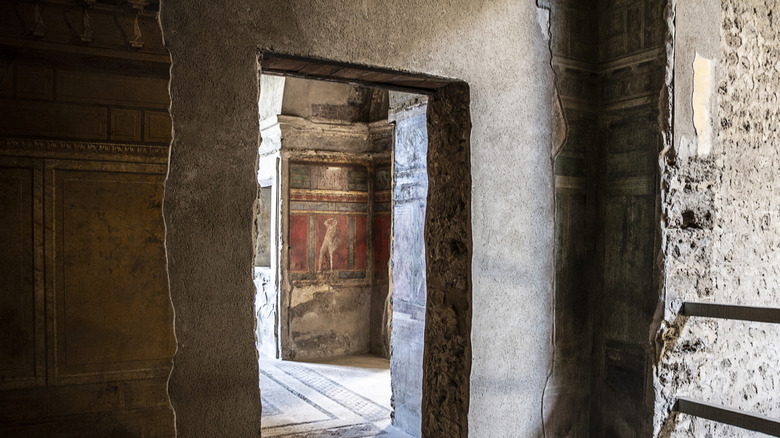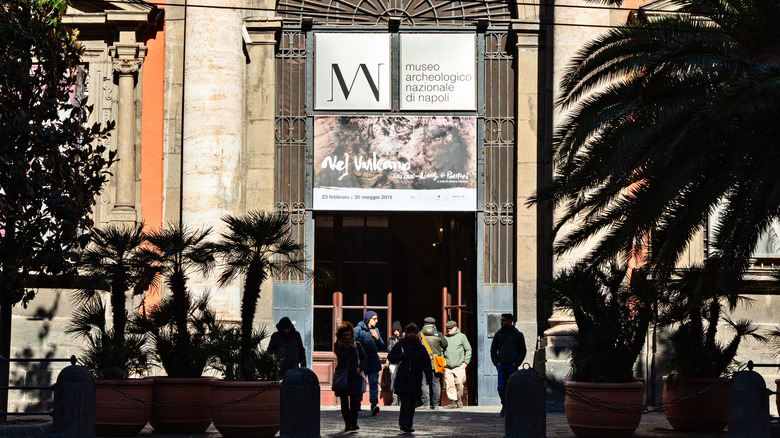Rick Steves Says No Trip To Pompeii Is Complete Without A Stop To See The Forbidden 'Secret Room' Frescoes
If you've never been there before, you may be wondering whether Pompeii is a tourist trap or a must-see on your vacation to Italy. According to travel expert Rick Steves, visiting Europe's ancient sites allows you to appreciate history without needing to go back to school. He advocates for a trip to Pompeii on his website: Thanks to the volcanic eruption that preserved it, frozen in time, "its ruins offer the best look anywhere at life in an ancient Roman town, with its gridded street plan, villas and homes, commercial buildings, public baths, and colorful frescoes left remarkably intact." However, Steves says that no trip to Pompeii is complete without dropping into the National Archaeological Museum of Naples (MANN) to see the forbidden Secret Room.
The colorful frescoes within this room offer a truly candid look into the tastes of the ancient Romans — too candid, in fact, for the delicate imaginations of Italians during the Romantic period, when they were first discovered. To quote Steves, the artworks "were considered so bawdy that by the time they made it here, in 1819, they could be viewed only with permission from the king." It took nearly 200 years for the museum's curators to exhibit the Secret Room for public viewing. Opened in 2000, the updated display was described as "exhaustively illustrat[ing] the different aspects of sexuality in the ancient world" (via MANN).
In addition to real paintings from the walls of wealthy homes, the Secret Room contains at least 250 suggestive banquet furnishings, phallus-shaped street decor, and other erotic objects, with more added regularly. As one Reddit user in an r/Archaeology subreddit put it following a discovery of more frescoes in 2024, "The more we learn about Pompeii the more it feels like the Spring Break vacation town of the Roman Empire."
Exploring the king's Secret Room in Naples
Pompeii's erotic frescoes, along with most of its movable artifacts, wound up in Naples shortly after their discovery at the behest of King Ferdinand IV. He compiled an array of the best discoveries from across Pompeii and Herculaneum (another town destroyed during Mount Vesuvius' eruption), which today make up the collections of the National Archaeological Museum of Naples. On his website, Rick Steves calls it "one of the world's great museums of ancient art." Although the king's Secret Room is listed on the museum's webpage and marked on its guided tour route, a barred entry gate does guard the interior — a modest warning of the room's contents, particularly worth noting for those traveling with children.
But to those who are curious enough to look, Steves says the room's statues and frescoes offer a glimpse into the tastes and everyday entertainment of wealthy Pompeiians, who would have had these pieces commissioned to show off to guests. The artworks range from humorous to erotic to "simply beautiful," as Steves puts it. But he adds, with a proverbial wink, "You'll have to come here in person to actually see that."
A detour to the museum offers a more complete picture of the once-flourishing city of Pompeii, argues Steves, especially given the contrast between the two urban landscapes you're offered. The National Archaeological Museum is just a 30-minute drive from Pompeii, accessible via the Campania Express train, the Circumvesuviana commuter train, or shuttle buses that run between the city and its popular archaeological satellite. Naples may not be as dirty and dangerous as the internet makes it out to be, but it's a far cry from the ancient fast-food counters, streets, and plaster casts that populate Pompeii's ruins.

